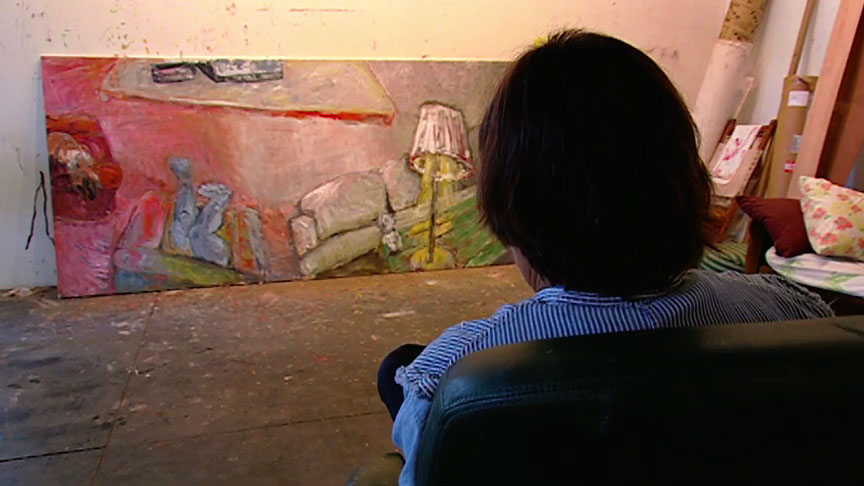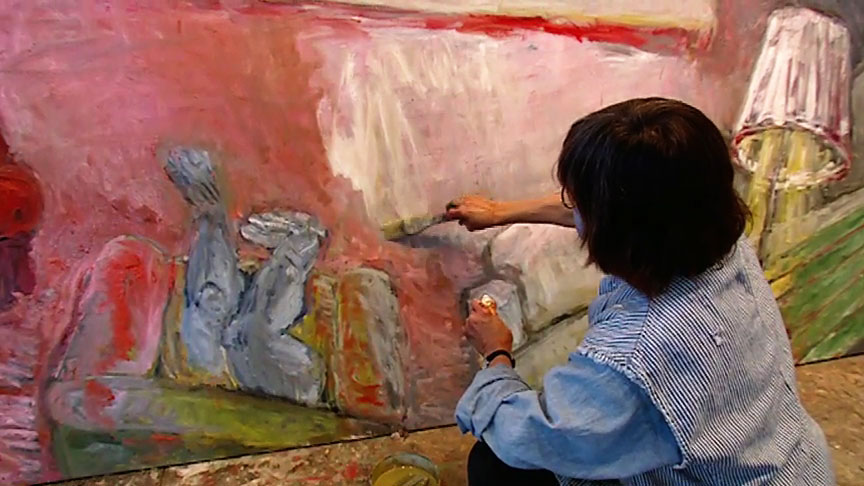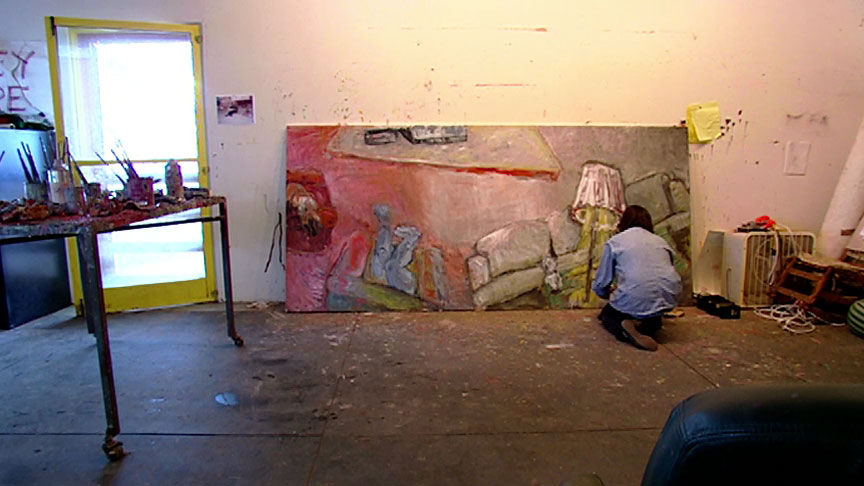Interview
The Studio

Susan Rothenberg in her studio, New Mexico, 2004. Production still from the Art in the Twenty-First Century Season 3 episode, Memory. © Art21, Inc. 2005.
Susan Rothenberg discusses her 2003 painting Red Studio, as well as the process she’s developed for composing and painting her pictures.
ART21: Talk about what influenced this painting, Red Studio.
ROTHENBERG: Matisse’s Red Studio. I had just come back from having a show in New York. I didn’t want to be in the place where you can’t continue what you are doing and don’t know what you’re going to do. I had never tried to do an interior this specific, but I didn’t know what to do, so I said, “I’m going to try it.”
I had a lot of fun painting it. I’ve started the second painting about the studio, and I have a third painting in mind. I had a blast with it. I had a lot of fun using fifteen and twenty different color reds. I think it has a funny kind of presence. It feels like my studio. I think the second painting will expand the sense of where a person paints. In the third studio, I want to make the room implode and put the corners in the middle.
ART21: There’s a floating quality to the work—what is that?
ROTHENBERG: I had been looking at Matisse and reading a book about Picasso and the relationship of his paintings to his studio. And I thought—since I wasn’t locked into any subject at this moment, and I didn’t want to enter a work stoppage and be sitting around here in an empty room—“I’m going to try painting my studio, but I’m going to try painting it red à la Matisse. It won’t be the same—it won’t be subject to the same symbolism, because I’m not a symbolist. It’s simply some of the elements that exist here: dogs, tables, bare canvases, rolls of paper, and me.”
It’s the second self-portrait or attempt at a self-portrait I’ve ever done. The other one had paper tabs, as in a paper-doll mask, and this one apparently has no neck or arms—just clothes and shoes. But I wanted to be in there, in my studio. It’s me barely present, me there—not working, not sitting down reading, not messing with the dogs. Just my presence, which is as much or as little physicality as that bare canvas in the background or that table or this stretcher bar. It’s just me in my studio and a self-portrait—a presence of myself in here, where I always am.
I think artists almost always end up turning to what’s around them, what’s in their environment or outside their window. Not all artists, and certainly not abstract artists . . . But I spend a lot of time in this room. It’s not red; it’s white. But I wanted to give it the vivacity of a special and heated-up kind of place. I’ve never painted a painting like this.

Susan Rothenberg in her studio, New Mexico, 2004. Production still from the Art in the Twenty-First Century Season 3 episode, Memory. © Art21, Inc. 2005.
ART21: Where did you start?
ROTHENBERG: The first thing was a bare canvas on a wall with dots for staples. Then I started locating that piece of furniture, that dog. As I said before, I almost always end up looking down into my spaces, in any kind of painting I’m doing these days, whether it’s a result of living in New Mexico or being on a ladder. But I started to locate the spaces. Then it was the t-shirt; then it was the pants. Then it was working the spaces between the objects and using about fifteen different reds to activate the different parts of the studio. I still think I have a little more work to do on it. But it came easier than I thought it could. It seemed too complicated for my brain to handle, yet it wasn’t. That was a fun thing for me to know—that I can handle more complicated spaces. And I don’t know where it will lead.
ART21: You started by drawing on canvas?
ROTHENBERG: I started with drawing. I think, in this case, I was a little scared. I was pretty timid, so I started with a pencil, and then I quickly got into a dirty brush ’til I got where the window is. I didn’t know how to paint this table, but I painted the table anyway. And then, as quickly as I could, I laid in this ocher tone to begin to find out what reds I was using. I used a dirty red tone. And then I used eighteen different reds and grays and some purple. But I laid down the tone that I knew the painting was going to have. And I figured out then what was going to be white and what was going to be yellow, and how much color the painting could carry and still be the red studio. And it just evolved over the days. You see dead spots, and you enliven those. And then that makes that spot maybe look a little dead there, so you put some orange up there, and it all responds to what you’ve done.
I think Jasper Johns said, “Do something and then do something else to it, and then do something else to it.” And there you go; you’re painting.

Susan Rothenberg in her studio, New Mexico, 2004. Production still from the Art in the Twenty-First Century Season 3 episode, Memory. © Art21, Inc. 2005.
ART21: Does the painting resemble a map?
ROTHENBERG: Yes. This is in one corner; that is in one corner. That’s my favorite wall to paint on. That’s a piece of furniture I got from a bar. That’s my file cupboard. That’s the chair I sit in. This is a stretcher bar that was in my field of vision. Those are some of my dogs. Everything in here is literal, painted to the point where it’s there, but not to the point where you know what this is this and this is and this is. It was a blast to paint.
ART21: Can you talk about abstraction?
ROTHENBERG: I can’t use the word abstraction. I’m a very literal-minded person. I know my paintings. I know this isn’t a real figure because it doesn’t have any arms. At one point, it had hands in the pockets without arms attached. And I thought, “Well, are you doing a figure, or are you doing this presence? You’re doing the presence.” So, I let go of whatever I needed to, and I kept what I wanted. And I do a lot of that in making painting. I edit: “Is that doing anything for me? Is that carrying its weight in that part of the canvas?” And if it’s not, it’s scraped out.
ART21: How has moving from New York to New Mexico changed your work?
ROTHENBERG: The first year was a very hard adjustment—just to the amount of light here. When we built the big adobe fireplace, I said, “That’s where I would like to live, that’s what I would like my studio to be like.” So, I made modifications in my studio plan to cut out some light and to reproduce the New York situation, of bars of floodlights. I’m glad I did.

Susan Rothenberg in her studio, New Mexico, 2004. Production still from the Art in the Twenty-First Century Season 3 episode, Memory. © Art21, Inc. 2005.
ART21: What gets you into the studio?
ROTHENBERG: We have developed a pattern. Bruce [Nauman] usually makes the coffee; we read in bed for twenty-five, thirty minutes. Shower, sometimes. He does the horses. I feed the chickens and the dogs. He throws hay and gets the newspaper. I walk the dogs for half an hour, forty-five minutes, looking for arrowheads and whatnot. Then, the studio: I look at what I did, look around, read, don’t get much done before noon. Go in and eat lunch, go back to the studio; sometimes I work out. But the bulk of the afternoon, until five-thirty or six, is studio time, painting time.
I believe very strongly that if you’re not in your studio physically most every day, you’ve denied the possibility of anything happening. So, even if you’re reading a detective novel, you should be there. I don’t go to the studio at night anymore, unless I’m on a deadline or fussed at Bruce; then I go back. It’s my sanctuary. It’s a great studio. It’s a great place to have a studio.
ART21: What makes you continue to paint?
ROTHENBERG: What makes me continue to make paintings? I don’t know how to do anything else. If you don’t know what you’re doing out here in the Southwest, in this kind of isolation, if you don’t understand that you’re supposed to work and have a purpose to every day, you’re going to float off into the stratosphere, or move very quickly back to an urban center.
You have to commit to your work. You have to find things that interest you and find interesting ways of rendering them. You have to fight yourself at every turn, so that you’re not repetitive or taking an easy solution. I’m able to work through periods when there’s no real important idea in my mind. Bruce is different. Bruce suffers much more than I do because unless a piece is fully realized and cooking in his brain for a while, he doesn’t have to make work. That’s why he’s gotten so interested in ranching, riding, and horsemanship—because he needs to fill his days with something substantive that’s not dependant on artistic inspiration.
I can draw. I can learn to make a clay pot like the pots that are on the land. But painting—if I didn’t do that, I couldn’t live here. And probably I couldn’t live anywhere, because I don’t know what else I would be doing but reading all day.



